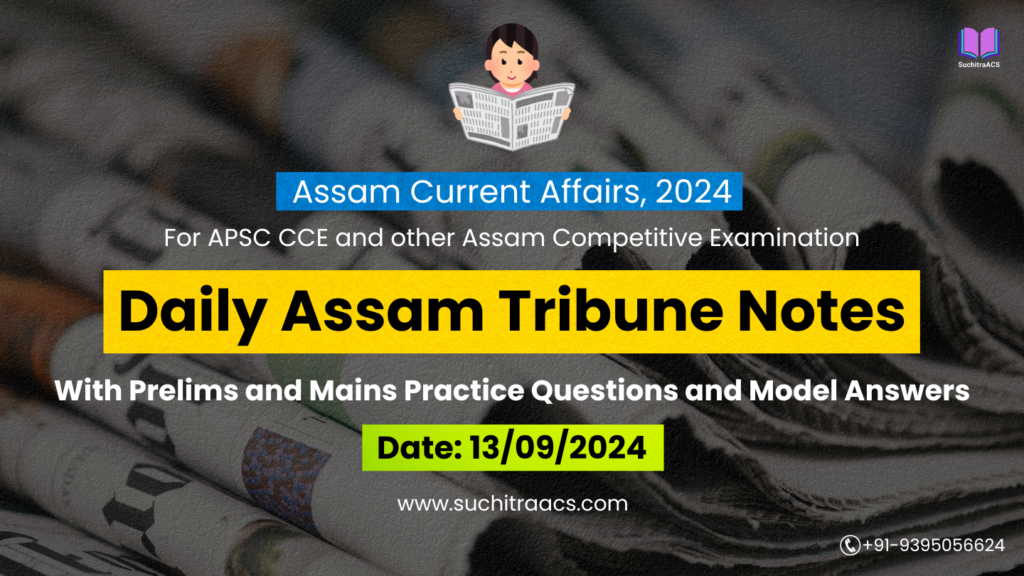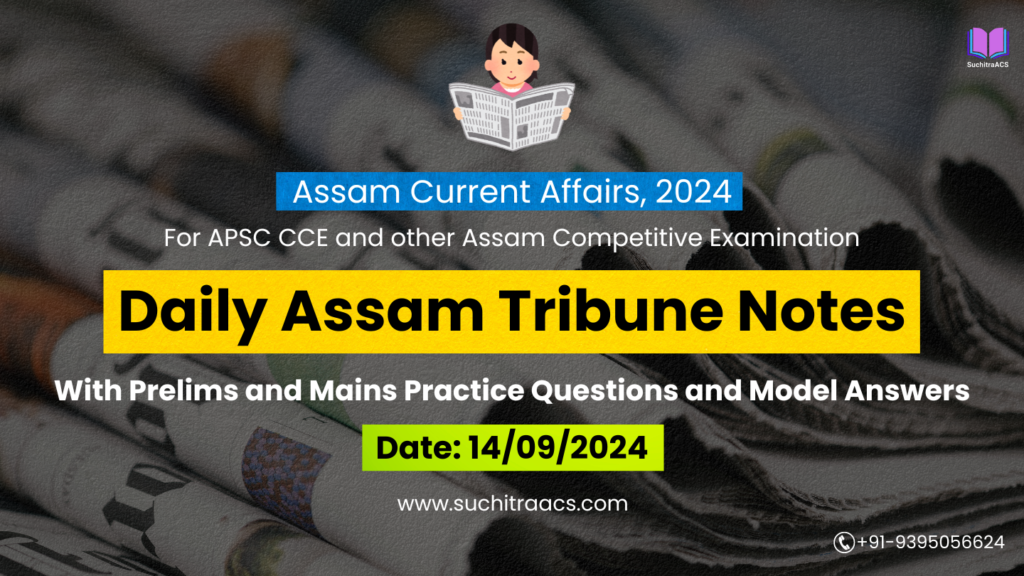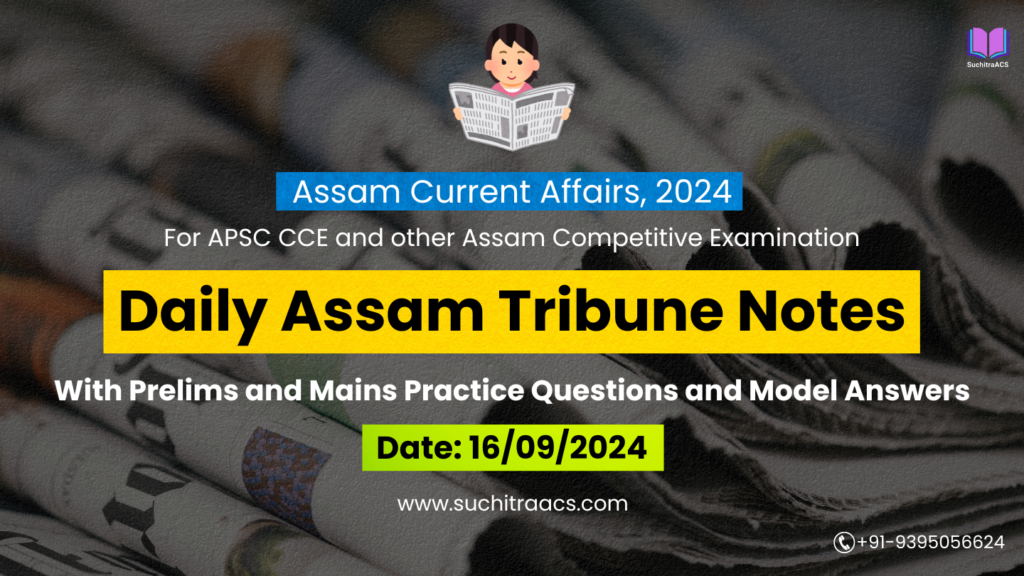1. Recommendations of the BK Sharma Committee on Clause 6 of the Assam Accord
GS Paper II – Polity, Governance
Introduction:
The BK Sharma Committee submitted 52 recommendations to implement Clause 6 of the Assam Accord, aimed at protecting the cultural, linguistic, and land rights of the indigenous people of Assam. Clause 6 is crucial in ensuring the socio-political protection of the Assamese population.
Key Points:
- Objective: To ensure constitutional, legislative, and administrative safeguards for the Assamese people.
- Land Rights:
- Protect land rights of indigenous people by prohibiting land transfer to non-indigenous individuals, except for specific cases (industrialization, infrastructure development).
- Implement strict provisions of the Assam Land Revenue Regulation Act, 1886.
- Cultural Safeguards: Protecting the language and culture of Assam’s indigenous people.
- Agricultural Land: Ban the conversion of agricultural land for non-agricultural purposes.
- Land Tribunals: Establish land tribunals in all districts to settle land disputes efficiently.
Prelims Focus:
- BK Sharma Committee: A panel created to implement Clause 6 of the Assam Accord.
- Assam Land Revenue Regulation, 1886: Key legislation to protect indigenous land rights.
Mains Focus:
- Constitutional Safeguards:
- Ensuring indigenous rights are safeguarded through constitutional provisions.
- Protecting Assam’s land, language, and cultural identity through legislation.
- Challenges:
- Land encroachments and proper identification of indigenous people.
- Difficulties in balancing development needs (industrialization) with protecting land rights.
Conclusion:
The implementation of the BK Sharma Committee’s recommendations is crucial for preserving the socio-political and cultural identity of Assam’s indigenous people. However, success depends on striking a balance between protecting land rights and enabling economic growth.
2. Financial Assistance Released to Assam for Disaster Response
GS Paper III – Disaster Management
Introduction:
The Ministry of Home Affairs (MHA) released ₹716 crore to Assam under the State Disaster Response Fund (SDRF) and the National Disaster Response Fund (NDRF) to manage the aftermath of heavy monsoon rains, floods, and landslides in the state.
Key Points:
- Financial Assistance: ₹716 crore has been allocated as part of the central share for disaster relief.
- Flood and Landslide Impact: Assam experienced severe flooding and landslides during the monsoon, damaging infrastructure, homes, and livelihoods.
- Assessment by IMCT: The Inter-Ministerial Central Teams (IMCTs) conducted an on-ground assessment of the damages in Assam.
Prelims Focus:
- State Disaster Response Fund (SDRF): Fund used for disaster management, with contributions from both the state and central governments.
- National Disaster Response Fund (NDRF): Provides financial assistance to states affected by large-scale disasters.
Mains Focus:
- Disaster Management and Preparedness:
- The release of funds indicates the need for better disaster preparedness and response mechanisms.
- Challenges of managing recurring floods and landslides in Assam.
- Utilization of Funds:
- Efficient use of funds for resettlement, infrastructure repair, and disaster mitigation efforts.
- Long-term solutions like flood control infrastructure and better urban planning to prevent future disasters.
Conclusion:
The release of funds for disaster management is critical to mitigating the damage caused by natural disasters in Assam. However, a stronger focus on disaster resilience and long-term planning is necessary to reduce the recurring impact of such disasters.
3. Power Procurement by Assam from Kalai II Hydroelectric Project
GS Paper III – Infrastructure, Energy Security
Introduction:
The Assam government approved the procurement of 200 MW of power from the Kalai II Hydroelectric Project in Arunachal Pradesh to meet the growing electricity demand in the state.
Key Points:
- Power Demand: Assam faces increasing electricity demand due to urbanization and industrialization.
- Kalai II Hydroelectric Project: Power will be procured at ₹5.46 per unit from the Arunachal-based project.
- Strategic Move: This procurement helps Assam bridge the power deficit and supports economic growth.
Prelims Focus:
- Kalai II Hydroelectric Project: Located in Arunachal Pradesh, provides renewable energy to the northeastern states.
- Power Deficit in Assam: Assam’s electricity demand is rising, necessitating external procurement.
Mains Focus:
- Energy Security:
- Assam’s increasing demand for power requires enhanced energy infrastructure and renewable energy sources.
- Hydropower as a sustainable energy solution for Assam’s energy needs.
- Challenges:
- Transmission issues: Ensuring efficient power transmission from remote areas to urban centers.
- Environmental Impact: Balancing the need for energy with the environmental impact of large hydroelectric projects.
Conclusion:
The procurement of power from the Kalai II Hydroelectric Project is a strategic step towards securing energy for Assam’s growth. With a focus on renewable energy, this move can address Assam’s power deficit, provided the state strengthens its transmission infrastructure and ensures minimal environmental impact.
4. Water Supply Project for Jagiroad Approved by Assam Cabinet
GS Paper II – Governance, Infrastructure Development
Introduction:
The Assam government approved a ₹121.36 crore water supply project for Jagiroad, aiming to improve access to clean drinking water in the region. This project is part of the state’s larger initiative to enhance urban infrastructure and public welfare.
Key Points:
- Budget Approval: ₹121.36 crore has been allocated for the project, which will benefit the urban population of Jagiroad.
- Infrastructure Development: The project focuses on improving water distribution systems, ensuring a consistent supply of safe drinking water.
Prelims Focus:
- Water Supply Project: Infrastructure project aimed at enhancing drinking water access in Jagiroad.
- Government Funding: ₹121.36 crore allocated for the water supply project.
Mains Focus:
- Urban Governance and Public Welfare:
- Importance of clean water access as a fundamental part of urban infrastructure development.
- Addressing the growing demand for water in rapidly urbanizing towns like Jagiroad.
- Challenges:
- Water Management: Ensuring efficient management of water resources to avoid water scarcity in the future.
- Project Implementation: Overcoming challenges like delays in infrastructure projects and ensuring proper maintenance post-construction.
Conclusion: The water supply project for Jagiroad is a crucial infrastructure initiative that will enhance public health and urban governance. Timely implementation and effective management will be key to ensuring that the benefits reach the intended population.
APSC Prelims Practice Questions
1. Which of the following recommendations were made by the BK Sharma Committee for the implementation of Clause 6 of the Assam Accord?
- Ban the conversion of agricultural land for non-agricultural purposes.
- Establish land tribunals in every district.
- Allow the transfer of indigenous land to non-indigenous people for industrial purposes.
Select the correct answer using the code below:
(a) 1 and 2 only
(b) 1 and 3 only
(c) 2 and 3 only
(d) 1, 2, and 3
Answer: (a) 1 and 2 only
Explanation:
- Statement 1 is correct: The committee recommended banning the conversion of agricultural land for non-agricultural purposes to protect indigenous rights.
- Statement 2 is correct: The committee also recommended establishing land tribunals in all districts to settle land disputes.
- Statement 3 is incorrect: The transfer of indigenous land to non-indigenous people was not recommended, except under strict conditions for public welfare (e.g., industrialization for state development).
2. What is the primary purpose of the ₹716 crore fund released by the Ministry of Home Affairs to Assam?
(a) To support the state’s energy infrastructure development
(b) For disaster response and management after floods and landslides
(c) To fund new power projects in the northeastern region
(d) For the implementation of urban water supply projects
Answer: (b) For disaster response and management after floods and landslides
Explanation:
The ₹716 crore released by the Ministry of Home Affairs to Assam is part of the State Disaster Response Fund (SDRF) and the National Disaster Response Fund (NDRF). The funds were allocated to assist Assam in managing the aftermath of floods and landslides, which caused widespread damage.
3. The Assam government’s procurement of power from the Kalai II Hydroelectric Project is primarily intended to:
(a) Reduce Assam’s dependency on coal-based power
(b) Address the increasing power demand due to urbanization and industrial growth
(c) Increase Assam’s renewable energy capacity in the wind energy sector
(d) Improve rural electrification rates in the northeastern region
Answer: (b) Address the increasing power demand due to urbanization and industrial growth
Explanation:
The power procurement from the Kalai II Hydroelectric Project in Arunachal Pradesh is part of Assam’s strategy to address the increasing power demand due to urbanization and industrial growth. This hydropower project will provide 200 MW of power to Assam, helping meet its electricity requirements.
4. What is the significance of the water supply project approved for Jagiroad by the Assam government?
(a) It aims to develop irrigation facilities for agriculture.
(b) It focuses on providing clean drinking water to the urban population.
(c) It will provide wastewater management solutions to the region.
(d) It is a major initiative for flood management in the Brahmaputra basin.
Answer: (b) It focuses on providing clean drinking water to the urban population.
Explanation:
The Jagiroad water supply project, with an allocation of ₹121.36 crore, is focused on improving the clean drinking water supply for the urban population. It is part of a broader initiative to enhance urban infrastructure and public welfare.
5. The BK Sharma Committee, formed to implement Clause 6 of the Assam Accord, aims to safeguard which of the following aspects for the indigenous people of Assam?
(a) Economic and trade rights
(b) Religious freedom and rights
(c) Land, cultural, and linguistic rights
(d) Tax exemptions and financial aid
Answer: (c) Land, cultural, and linguistic rightsExplanation:
The BK Sharma Committee was formed to implement Clause 6 of the Assam Accord, which primarily focuses on protecting the land, cultural, and linguistic rights of Assam’s indigenous people. These safeguards are intended to preserve the socio-political identity of the Assamese population.
APSC Mains Practice Question
Question:
“Discuss the significance of the BK Sharma Committee’s recommendations on Clause 6 of the Assam Accord for safeguarding the rights of indigenous people in Assam. What challenges might arise during the implementation of these recommendations, and how can they be addressed?”
(Answer in 250 words)
Model Answer:
Introduction:
The BK Sharma Committee was formed to provide recommendations on the implementation of Clause 6 of the Assam Accord, which focuses on safeguarding the cultural, linguistic, and land rights of Assam’s indigenous people. The committee’s report includes 52 recommendations aimed at ensuring the protection of the socio-political identity of the Assamese population.
Significance of the Recommendations:
- Land Rights: The committee proposed stricter implementation of the Assam Land Revenue Regulation Act, 1886, to protect indigenous land from being transferred to non-indigenous individuals. This is crucial to prevent encroachment and land alienation.
- Cultural and Linguistic Safeguards: Recommendations to protect the Assamese language and cultural heritage are vital to maintaining the unique identity of the indigenous people.
- Establishment of Land Tribunals: The committee suggested the formation of land tribunals in every district to settle disputes efficiently and ensure that the rights of indigenous people are upheld.
Challenges in Implementation:
- Identification of Indigenous People: One major challenge is the accurate identification of indigenous populations, as there are multiple ethnic groups with varied claims to indigenous status.
- Balancing Development and Protection: Ensuring that industrial development does not infringe upon indigenous land rights will be a key concern, especially when land is required for public projects.
- Political and Administrative Will: Proper enforcement of the recommendations requires strong political and administrative commitment to avoid delays and inconsistencies in execution.
Suggestions for Addressing Challenges:
- Clear Criteria for Identification: The government should establish transparent criteria for determining indigenous status to avoid disputes and ensure inclusivity.
- Consultation with Stakeholders: Involving local communities, civil society, and experts in the implementation process can help address concerns and ensure smooth execution.
- Balanced Approach: A balanced approach is needed to ensure development and economic growth while safeguarding the land rights of indigenous people.
Conclusion:
The recommendations of the BK Sharma Committee are critical to preserving the rights and identity of the indigenous people of Assam. While challenges in implementation exist, a transparent and participatory approach can ensure that the goals of Clause 6 are achieved effectively.
💡 APSC CCE Mains Answer Checking Service!

🔔 Join Our WhatsApp Study Group!
For exclusive access to premium quality content, including study materials, current affairs, MCQs, and model answers for APSC CCE and other Assam competitive exams.
Click here to join: SuchitraACS Study WhatsApp Group
📚 Want to know more about SuchitraACS’s most affordable courses?
Click here to know more: SuchitraACS Courses for APSC CCE and Assam Competitive Examinations




